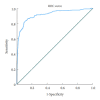A Predictive Model of Failure to Rescue After Thoracolumbar Fusion
- PMID: 38171301
- PMCID: PMC10762394
- DOI: 10.14245/ns.2346840.420
A Predictive Model of Failure to Rescue After Thoracolumbar Fusion
Abstract
Objective: Although failure to rescue (FTR) has been utilized as a quality-improvement metric in several surgical specialties, its current utilization in spine surgery is limited. Our study aims to identify the patient characteristics that are independent predictors of FTR among thoracolumbar fusion (TLF) patients.
Methods: Patients who underwent TLF were identified using relevant diagnostic and procedural codes from the National Surgical Quality Improvement Program (NSQIP) database from 2011-2020. Frailty was assessed using the risk analysis index (RAI). FTR was defined as death, within 30 days, following a major complication. Univariate and multivariable analyses were used to compare baseline characteristics and early postoperative sequelae across FTR and non-FTR cohorts. Receiver operating characteristic (ROC) curve analysis was used to assess the discriminatory accuracy of the frailty-driven predictive model for FTR.
Results: The study cohort (N = 15,749) had a median age of 66 years (interquartile range, 15 years). Increasing frailty, as measured by the RAI, was associated with an increased likelihood of FTR: odds ratio (95% confidence interval [CI]) is RAI 21-25, 1.3 [0.8-2.2]; RAI 26-30, 4.0 [2.4-6.6]; RAI 31-35, 7.0 [3.8-12.7]; RAI 36-40, 10.0 [4.9-20.2]; RAI 41- 45, 21.5 [9.1-50.6]; RAI ≥ 46, 45.8 [14.8-141.5]. The frailty-driven predictive model for FTR demonstrated outstanding discriminatory accuracy (C-statistic = 0.92; CI, 0.89-0.95).
Conclusion: Baseline frailty, as stratified by type of postoperative complication, predicts FTR with outstanding discriminatory accuracy in TLF patients. This frailty-driven model may inform patients and clinicians of FTR risk following TLF and help guide postoperative care after a major complication.
Keywords: Frailty; NSQIP; Outcomes; Risk analysis index; Spine surgery; Thoracolumbar fusion.
Conflict of interest statement
The authors have nothing to disclose.
Figures
Comment in
-
Clinical Utility and Actionability of Failure to Rescue Prediction Model for Thoracolumbar Fusion: A Focus on Variable Relevance - A Commentary on "A Predictive Model of Failure to Rescue After Thoracolumbar Fusion".Neurospine. 2025 Jun;22(2):615-616. doi: 10.14245/ns.2550280.140. Epub 2025 Jun 30. Neurospine. 2025. PMID: 40625021 Free PMC article. No abstract available.
References
-
- Thirumala P, Zhou J, Natarajan P, et al. Perioperative neurologic complications during spinal fusion surgery: incidence and trends. Spine J. 2017;17:1611–24. - PubMed
-
- Gephart MG, Zygourakis CC, Arrigo RT, et al. Venous thromboembolism after thoracic/thoracolumbar spinal fusion. World Neurosurg. 2012;78:545–52. - PubMed
-
- Silber JH, Williams SV, Krakauer H, et al. Hospital and patient characteristics associated with death after surgery. A study of adverse occurrence and failure to rescue. Med Care. 1992;30:615–29. - PubMed
-
- Scali ST, Giles KA, Kubilis P, et al. Impact of hospital volume on patient safety indicators and failure to rescue following open aortic aneurysm repair. J Vasc Surg. 2020;71:1135–46.e4. - PubMed
LinkOut - more resources
Full Text Sources


